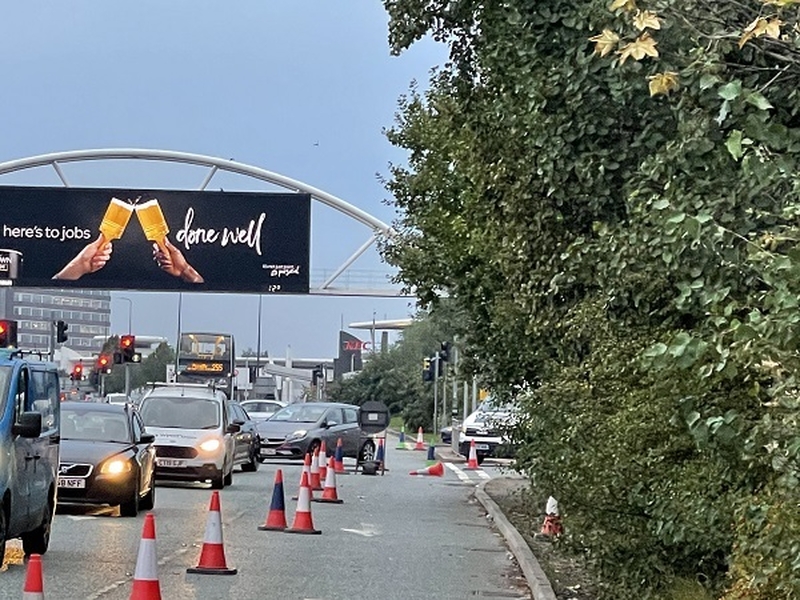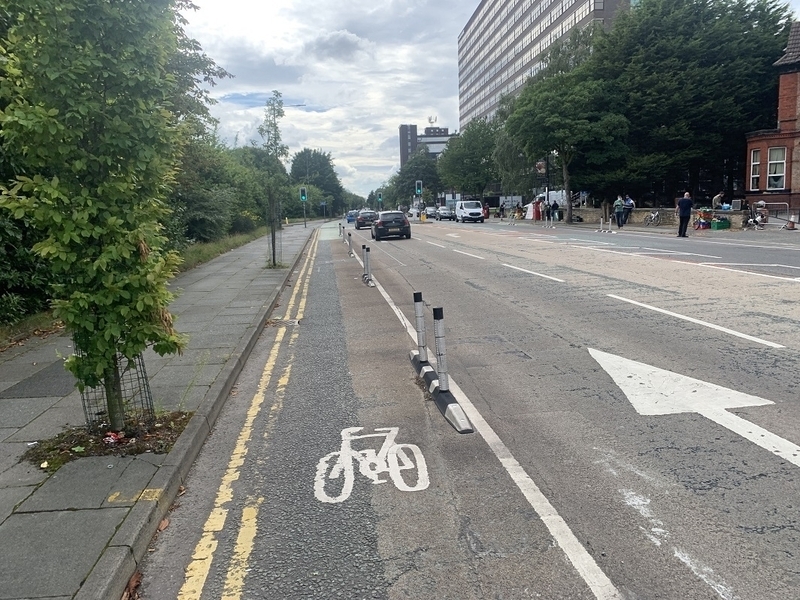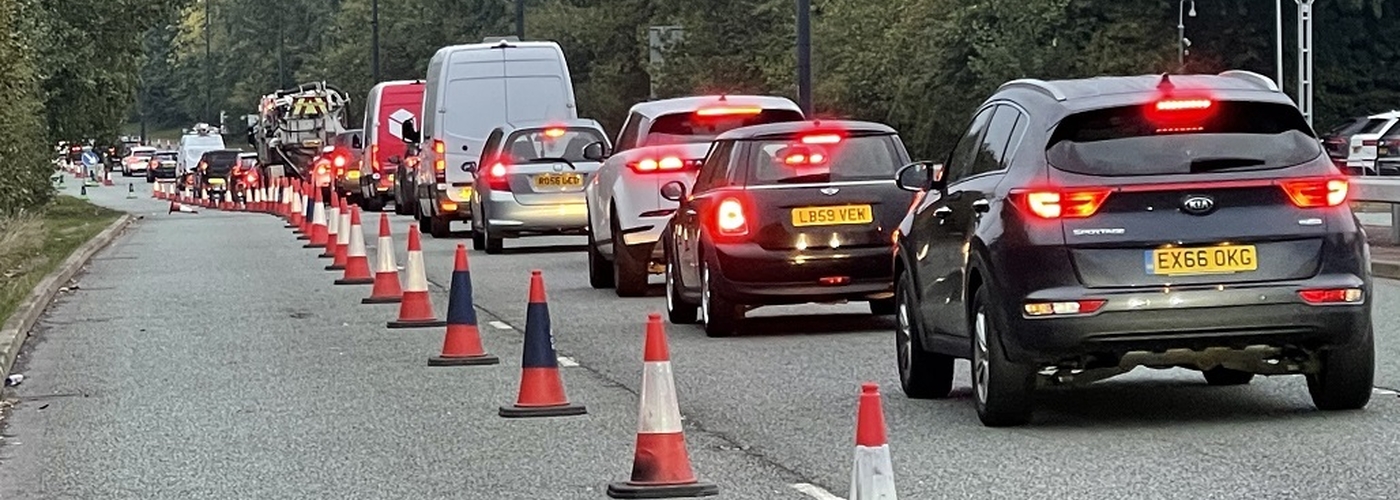Jonathan Schofield talks to Claire Stocks of WalkRideGM about active transport in Greater Manchester
“We are expecting to be able to make the decision to commence consultation shortly.”
This was the one-sentence response from Trafford Metropolitan Borough Council in late September to an enquiry about the cone zones on Chester Road, Bridgewater Way and Edge Lane. It's the most woolly reply I've had from a council.
Shambolic schemes such as the coning-off of Chester Road irritate vehicle users and doesn't make cycling safer
The cone zones clearly weren’t up for discussion by Trafford. Anybody travelling out of the city south west, or travelling from the south west into the city centre, will be aware of the problem. The cone zones entail giving over a whole carriageway for bikes and mostly leaving just one for motor vehicles. You are more likely to find traffic jams than bikes in these coned areas.
The response to a June request for more information promised there’d be a consultation by August. Finally, in October a consultation was announced from 1 November running until 12 December.
Trafford Council, in another example of mangled bureaucracy-speak, said: “The consultation is not intended to be a referendum but is intended to gauge viewpoints from the public in identifying new and relevant information to consider when finalising a decision to replace the pop-up cycle lane."
Eh, what?
Cllr Stephen Adshead, who has a fabulously grand role as Executive Member for Environment, Air Quality and Climate Change, said: “We have now reached a point where more cars are back on the roads and we need to assess how we manage the increased traffic whilst also supporting active travel.”

In practical terms, the coned-off areas have been as nonsensical as some of Trafford’s communication. I cycle frequently. Most mornings if scooting down, say the “temporary cycle lane” on Bridgewater Way I have it to myself, sans other cyclists. At 8am the other day I was pedalling alone while motor vehicles were jammed the whole length of Bridgewater Way in the other lane. It was bad for the economy and it was bad for the environment and it was bad for peace of mind in those vehicles.
Aside from that silliness, junctions within the coned-off area have been dangerous. I’ve found them troubling and I’m a confident cyclist. At left turns the cones just stop. Drivers lulled into thinking cyclists are safe in their special lanes often vear to cross without looking for bikes.
Trafford Council admitted this problem at the Chester Road, Edge Lane junction on 27 October when they removed the cones due to “safety concerns”. “The move comes ahead of (the) public consultation,” the Council said. So, let’s get this right, if to remove this part of an unpopular and failed scheme doesn’t need a consultation then they could remove the rest of it without one. There’s no record of consultation before the cones were installed.

Delivering the Bee Network?
I asked Claire Stocks of Walk Ride GM for her thoughts. Her organisation promotes “active travel” across Greater Manchester. I got more than I bargained for in an entirely reasonable and long response that’s worth quoting extensively. Stocks covers much more than just the cones on Chester Road but describes the nonsense as it happened and also some hope for a future policy that begins to be coherent.
“Over the last year the government gave more than £20m to Greater Manchester to speed up providing safer walking and cycling provision during the pandemic, when more people were staying local and avoiding public transport,” writes Stocks.
“GM’s walking and cycling commissioner, Chris Boardman, and his team proposed a 100km network of pop-up bike lanes, based on data of what might enable the highest number of people to get around.
“This network was never created save for the odd island of lonely traffic cones: and an opportunity to speed up a shift to low-carbon travel and help the large number of people without a car was missed. Car journeys are now back above pre-COVID levels in parts of GM.
“This failure indicates that something will have to change if our region is to deliver on its Bee Network vision which has now been backed in last week’s spending review to the tune of £1.07bn.
“Significant amounts of this will be available for walking and cycling schemes, so those councils who have thus far avoided making them now have the means to do so.
“The A56 pop-up lane is sadly a consequence of a breakdown in collective leadership and collaboration within GM.
“One leader, Andy Western in Trafford, was prepared to at least try. He and his team backed a proposal for the scheme on the busy A56, bisecting numerous communities in Manchester. This could have delivered a safe route from Altrincham into the city centre.
“Other councils dismissed the network idea, such as Manchester who said they preferred to focus on their own plans and permanent measures, and left the lane hanging at the border. Bolton withdrew a half-finished lane before it was even complete after a so-called consultation that was flawed in method and also misrepresented the findings - and are now blackballed from receiving any further walking and cycling funding. Bury were going to install their first bike lane - but soon scrapped the idea and there is still no safe bike route on roads in the borough.
“One by one the councils backed out of or sidestepped the network idea and so all that was ever really installed was teeny odds and sods - including this one lone lane on Chester Road, originally conceived as part of a network.
“And unlike schemes in other parts of the country where the cones were quickly replaced by more robust measures such as small fixings known as armadillos, or tall posts known as wands, Trafford just left in the cones. The net result is a scheme that satisfied no one."

A billion-pound opportunity
Claire continues: “During the initial period last summer when it ran from Sale all the way to Bridgewater Way, it was relatively well used, especially around places like Gorse Hill. But it ended up as a lane that led nowhere safely, nor linked to other safe routes, and was chipped away at to end up as two or three separate disconnected bits, with junctions not protected (junctions being the most dangerous part of any route for all road users especially cyclists), and no measures to make the temporary protection secure.
“Is it any wonder that it hasn’t taken off? Would we build a road or train line in this way ? No. And if we did, would we wonder why not many used it? No.
“This lane should serve as a symbol of what can’t happen again, and the need for leaders, their executives and officers to work together to enable people to get around safely without a car, via a safe network linking people with where they need to go.
“With £1.07bn heading our way, councils have an opportunity to get it sorted and build the 'cleaner greener transport system with walking and cycling embedded' that they have promised us, that our climate, environmental, pollution and congestion crisis demand, and for which future generations will only thank us.”
Thanks for that Claire Stocks, although at Confidentials we're not sure the way the UK builds train lines is perhaps a good example of efficiency: HS2 anyone? What is clear though, as Stocks eloquently points out, is a plan is needed to knit the ten boroughs of Greater Manchester together with a coherent transport policy that is light on the obfuscating words of bureaucratic press releases. Shambolic schemes such as the coning-off of Chester Road irritate vehicle users and doesn't make cycling safer.
The billboards over Bridgewater Way were sporting a Crown Paints ad as I cycled past recently with a strapline of "Here's to jobs done well". This one hasn't been. It remains a colossal waste of time except for one respect: a lesson in how not to deliver road management.

















